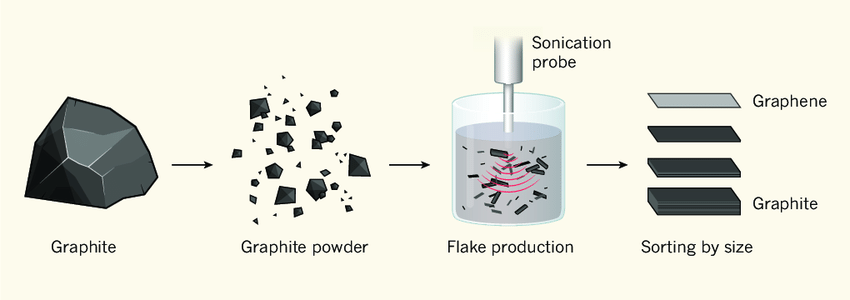Liquid-Phase Exfoliation: A Powerful Technique for Producing 2D Nanomaterials
What is Liquid-Phase Exfoliation?
Liquid-phase exfoliation (LPE) is a versatile and scalable method for producing two-dimensional (2D) nanomaterials from layered bulk crystals. It involves the use of liquid media, such as solvents or surfactants, to overcome the van der Waals forces holding the layers together, resulting in the separation of individual or few-layer nanosheets. LPE has emerged as a promising technique for the mass production of high-quality 2D nanomaterials for various applications.

Mechanism of Liquid-Phase Exfoliation
The LPE process relies on the interplay between the layered material and the liquid medium. The mechanism can be divided into three main steps:
- Dispersion: The layered bulk crystals are dispersed in a suitable liquid medium, such as organic solvents, aqueous surfactant solutions, or ionic liquids. The choice of liquid medium depends on the surface energy and chemical compatibility with the layered material.
- Exfoliation: The dispersed layered crystals are subjected to external forces, such as ultrasonication or shear mixing, which provide the energy necessary to overcome the van der Waals forces holding the layers together. This leads to the separation of individual or few-layer nanosheets from the bulk crystal.
- Stabilization: The exfoliated nanosheets are stabilized in the liquid medium through various mechanisms, such as solvent-nanosheet interactions, electrostatic repulsion, or steric hindrance. This prevents the re-aggregation of the nanosheets and maintains their dispersed state.
Factors Affecting Liquid-Phase Exfoliation
Several factors influence the efficiency and quality of the LPE process:
- Solvent Selection: The choice of solvent plays a crucial role in the LPE process. The solvent should have a surface energy that matches the surface energy of the layered material to minimize the energy cost of exfoliation. Commonly used solvents include N-methyl-2-pyrrolidone (NMP), dimethylformamide (DMF), and isopropanol (IPA).
- Surfactants: Surfactants can be used to enhance the dispersion and stabilization of the exfoliated nanosheets in aqueous media. They adsorb on the nanosheet surface and provide electrostatic or steric repulsion, preventing re-aggregation. Common surfactants include sodium cholate, sodium dodecyl sulfate (SDS), and Pluronic block copolymers.
- Exfoliation Method: The choice of exfoliation method, such as ultrasonication or shear mixing, affects the quality and yield of the exfoliated nanosheets. Ultrasonication is widely used due to its simplicity and effectiveness, but it can cause damage to the nanosheets. Shear mixing offers a gentler alternative, producing high-quality nanosheets with fewer defects.
- Processing Parameters: The processing parameters, such as the initial concentration of the layered material, the duration and power of the exfoliation process, and the centrifugation conditions, can significantly impact the yield and quality of the exfoliated nanosheets. Optimization of these parameters is essential for achieving high-quality 2D nanomaterials.
Advantages of Liquid-Phase Exfoliation
LPE offers several advantages over other exfoliation methods:
- Scalability: LPE is a scalable process that can produce large quantities of 2D nanomaterials, making it suitable for industrial-scale applications.
- Versatility: LPE can be applied to a wide range of layered materials, including graphene, transition metal dichalcogenides (TMDs), hexagonal boron nitride (h-BN), and metal oxides, enabling the production of diverse 2D nanomaterials.
- Cost-effectiveness: LPE is a relatively low-cost method compared to other exfoliation techniques, such as mechanical cleavage or chemical vapor deposition (CVD), as it does not require expensive equipment or high-temperature processes.
- Functionalization: LPE allows for the simultaneous exfoliation and functionalization of 2D nanomaterials by incorporating functional molecules or nanoparticles during the exfoliation process, enabling the production of hybrid or composite nanomaterials with tailored properties.
Applications of Liquid-Phase Exfoliated 2D Nanomaterials
2D nanomaterials produced by LPE have found applications in various fields:
- Electronics: LPE-produced 2D nanomaterials, such as graphene and TMDs, have been used in the fabrication of high-performance electronic devices, including transistors, sensors, and optoelectronic devices.
- Energy Storage: 2D nanomaterials have shown great potential in energy storage applications, such as supercapacitors and lithium-ion batteries, due to their high surface area, electrical conductivity, and electrochemical stability.
- Catalysis: The high surface area and exposed active sites of 2D nanomaterials make them attractive for catalytic applications, such as hydrogen evolution, oxygen reduction, and CO2 reduction reactions.
- Biomedical Applications: LPE-produced 2D nanomaterials have been explored for various biomedical applications, including drug delivery, biosensing, and tissue engineering, owing to their unique properties and biocompatibility.
Challenges and Future Perspectives
Despite the significant progress in LPE, several challenges remain to be addressed. One of the main challenges is the precise control over the size, thickness, and defect density of the exfoliated nanosheets. The development of advanced characterization techniques and standardized protocols for quality control is essential for ensuring the reproducibility and reliability of LPE-produced 2D nanomaterials.
Future research in LPE will focus on the optimization of the exfoliation process, the exploration of new layered materials, and the development of novel functionalization strategies. The integration of computational modeling and machine learning techniques will accelerate the discovery and optimization of LPE conditions for specific layered materials. Additionally, the scale-up of LPE processes and the development of continuous flow systems will be crucial for the industrial-scale production of high-quality 2D nanomaterials.
